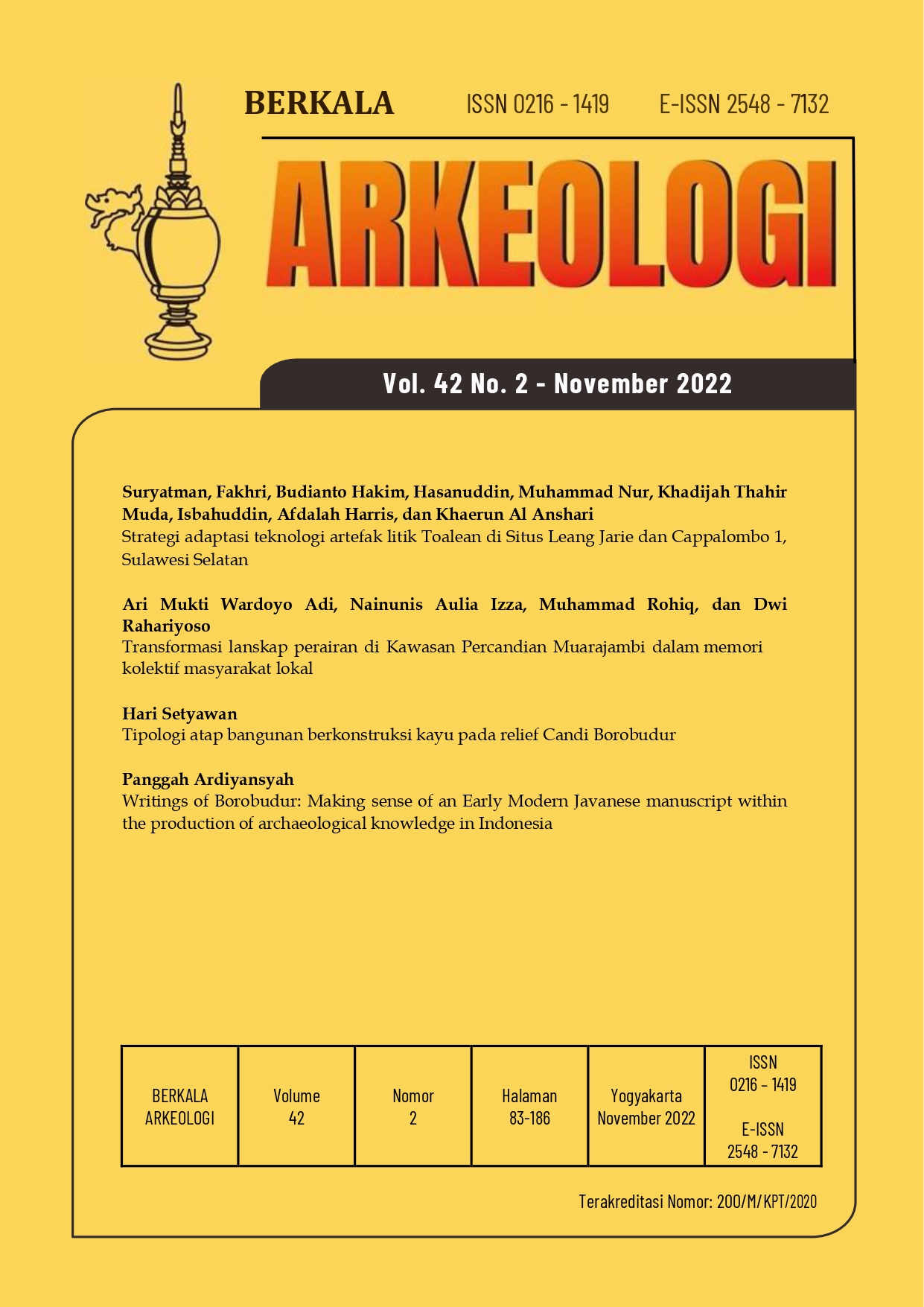Writings of Borobudur: Making sense of an Early Modern Javanese manuscript within the production of archaeological knowledge in Indonesia Tulisan-tulisan tentang Borobudur: Menempatkan naskah Jawa Modern Awal dalam produksi pengetahuan arkeologi di Indonesia
Main Article Content
Abstract
Kawasan Borobudur sebagai situs warisan budaya saat ini dapat diterjemahkan sebagai sebuah konstruksi cerita tentang keagungan masa lalu, penyesalan akan kehilangan, dan penyelamatan oleh otoritas kolonial, yang terarahkan oleh estetika yang dibangun pada masa kolonial. Tulisan ini membahas proses pembentukan pengetahuan historis tentang Borobudur dengan metode dekonstruksi sejarah berdasarkan analisis terhadap Babad Tanah Jawi, yang disusun dari akhir abad ke-18 sampai
dengan awal abad ke-19 oleh kraton Jawa. Hasil penelitian menunjukkan bahwa pada masa Jawa Modern Awal Borobudur memiliki kualitas spiritual dalam kehidupan masyarakat, berbeda dengan sudut pandang otoritas kolonial.
Article Details

This work is licensed under a Creative Commons Attribution-NonCommercial-ShareAlike 4.0 International License.
References
Acri, A. (2020). Yoga and meditation traditions in insular Southeast Asia. In S. Newcombe & K. O’Brien-Kop (Eds.), Routledge handbook of yoga and meditation studies. Routledge.
Acri, A., & Meyer, V. (2019). Indic-Islamic encounters in Javanese and Malay mystical literatures. Indonesia and the Malay World, 47(139), 277–284.
https://doi.org/10.1080/13639811.2019.1657723
Aljunied, S. M. K. (2005). Sir Thomas Stamford Raffles’ discourse on the Malay world: A revisionist perspective. Sojourn: Journal of Social Issues in Southeast Asia, 20(1), 1–22.
Anderson, B. (2006). Imagines communities: Reflections on the origin and spread of nationalism. Verso.
Anonymous. (1940). Babad Tanah Jawi vol. 18. Bale Pustaka.
Bloembergen, M., & Eickhoff, M. (2013). Exchange and the protection of Java’s antiquities: A transnational approach to the problem of heritage in Colonial Java. The Journal of Asian Studies, 72(4). https://doi.org/10.1017/S0021911813001599
Bloembergen, M., & Eickhoff, M. (2020). The politics of heritage in Indonesia: A cultural history. Cambridge University Press.
Borobudurpedia. (2020). Candi Borobudur. http://borobudurpedia.id/candiborobudur/
Brandes, J. L. A. (1901). Twee oude berichten over de Baraboedoer. Tijdschrift Voor
Indische Taal-. Land-En Volkenkunde, 44, 73–88.
Bratakesawa, R. (1928). Katrangan Cåndrasangkala. Bale Pustaka.
Diaz-Andreu, M. (2007). A world history of nineteenth-century archaeology: Nationalism, colonialism, and the past. Oxford University Press.
Fitriani, I. (2014). Hormati Sir Raffles, PT Pos luncurkan 20.000 perangko bergambar borobudur. Kompas.Com.
https://regional.kompas.com/read/2014/11/13/23334681/Hormati.Sir.Raf fles.PT.Pos.Luncurkan.20.000.Perangko.Bergambar.Borobudur
Gericke, J. F. C., & Roorda, T. (1901). Javaansch-Nederlansch handwoordenboek deel I. Johannes Müller and E.J. Brill.
Horne, E. C. (1974). Javanese-English dictionary. Yale University Press.
Krom, N. J. (1927). Barabudur, archaeological description. vol I. Martinus Nijhoff.
Kumar, A. (1984). On variation in babads. Bijdragen Tot de Taal-, Land- En Volkenkunde / Journal of the Humanities and Social Sciences of Southeast Asia, 140(2), 223–247. https://doi.org/https://doi.org/10.1163/22134379-90003414
Kumar, A. (1997). Java: A self-critical examination of the nation and its history. In A. Reid (Ed.), The last stand of Asian autonomies: Responses to modernity in the diverse states of Southeast Asia and Korea, 1750-1900 (pp. 321–343). Macmillan Press and St. Martin’s Press.
Lombard, D. (2020). Nusa Jawa: Silang budaya, kajian sejarah terpadu, vol. II: Jaringan Asia. Gramedia Pustaka Utama.
Miksic, J. (1990). Borobudur: Golden tales of the Buddhas. Bamboo Publising in association with Periplus Edition.
Moertono, S. (2009). State and Statecraft in Old Java: A Study of the Later Mataram Period, 16th to 19th Century. Equinox Publishing.
Purwanto, B. (2006). Gagalnya historiografi Indonesiasentris?! Ombak.
Raffles, T. S. (1817). The history of Java: Vol. II. Black, Parbury, and Allen.
Ras, J. J. (1987). The genesis of the Babad Tanah Jawi: Origin and function of the Javanese court chronicle. Bijdragen Tot de Taal-, Land- En Volkenkunde / Journal of the Humanities and Social Sciences of Southeast Asia, 143(2/3), 343–356. https://www.jstor.org/stable/27863843
Ricklefs, M. C. (1972). A consideration of three versions of the babad tanah djawi, with excerpts on the fall of Madjapahit. Bulletin of the School of Oriental and African Studies, 35(2), 285–315. https://doi.org/10.1017/S0041977X00109371
Ricklefs, M. C. (1983). The crisis of 1740-1 in Java: the Javanese, Chinese, Madurese and Dutch, and the fall of the court of Kartasura. Bijdragen Tot de Taal-, Land- En Volkenkunde / Journal of the Humanities and Social Sciences of Southeast Asia, 139(2), 268–290. https://doi.org/https://doi.org/10.1163/22134379-90003445
Ricklefs, M. C. (1998). Islamising Java : The long shadow of Sultan Agung. Archipel, 56, 469–482. https://doi.org/10.3406/arch.1998.3503
Rouse, J. (2003). Power/Knowledge. In The Cambridge Companion to Foucault (2nd ed., pp. 95–122). Cambridge University Press.
Roxas-Lim, A. (1983). Caves and bathing places in Java as evidence of cultural accommodation. Asian Studies: Journal of Critical Perspectives on Asia, 21, 107–175.
Sastrawan, W. J. (2020). How to read a chronicle. Indonesia and the Malay World, 48(140), 2–23. https://doi.org/10.1080/13639811.2020.1701325
Scheltema, J. F. (1912). Monumental Java. Macmillan and Co.
Scheurleer, P. L. (2007). Collecting Javanese antiquities: The appropriation of a newly discovered Hindu-Buddhist civilization. In P. ter Keurs (Ed.), Colonial Collections Revisited (pp. 71–114). CNWS Publications.
Scidmore, E. R. (1897). Java: Garden of the East. The Century Co.
Smith, L. (2006). Uses of heritage. Routledge.
Soekmono. (1976). Chandi Borobudur: A monument of mankind. Unesco Press.
Southworth, W. A. (2017). Twelve stone sculptures from Java. The Rijksmuseum Bulletin, 65(3), 244–275. https://www.jstor.org/stable/26266324
Steenbrink, K., Steenbrink, J., & Jansen, H. (1993). Dutch colonialism and Indonesian Islam: Contacts and conflicts 1596-1950. Rodopi.
Tiffin, S. (2016). Southeast Asia in ruins: Art and empire in the early 19th century. NUS Press.
Wessing, R. (1999). The sacred grove: Founders and the owners of the forest in West Java, Indonesia. In S. Bahuchet, D. Bley, H. Pagezy, & N. Vernazza-Licht (Eds.), L’homme et la forêt tropicale (pp. 59–73). Travaux de la Société d’Ecologie Humaine.
Wieringa, E. P. (1999). An old text brought to life again: A reconsideration of the ‘Final Version’ of the Babad Tanah Jawi. Bijdragen Tot de Taal-, Land- En Volkenkunde / Journal of the Humanities and Social Sciences of Southeast Asia,
(2), 244–263.
Zoetmulder, P. J. (1982). Old Javanese-English dictionary (S. O. Robson (ed.)). M. Nijhoff.

